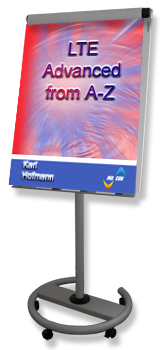 LTE Advanced from A-Z
LTE Advanced from A-Z
[2-day course, Euro 2,350.- (net) per participant]
 Training Course Description
Training Course Description
 The main focus of this course is the evolution of the LTE system based on Release 8/9 to LTE Advanced based on Release 10 and beyond (Release 11).
The main focus of this course is the evolution of the LTE system based on Release 8/9 to LTE Advanced based on Release 10 and beyond (Release 11).- The first sections include specifics of the LTE Advanced physical layer increasing the data rate per user in peak and average.
- Different sections deal with the enhanced radio concepts of LTE Advanced, namely: carrier aggregation, enhanced multiple antenna techniques for downlink and uplink, coordinated multipoint transmission and reception (CoMP). Each of the features is presented in its own section with focus on the details of the control signaling (for example CSI-RS, PUCCH Formats, DCI Formats, ..). Because CoMP as part of Release 11 is still in progress of standardization, details like the enhanced PDCCH (ePDCCH) will only be covered partly.
- The next sections discuss features which help to manage future LTE networks. This includes enhanced functionality of LTE Home Base Stations (HeNB), Heterogeneous Networks and LTE relays as well as using UE measurements to minimize drive tests. Special attention is put on features affecting the performance of UEs [for example the Almost Blank Subframe (ABS)].
- One section deals with the relay node as new architectural element in the network. Especially the type 1 relay nodes will impose a challenge in terms of interference mitigation. The structure of the new Un interface (R-PDCCH, R-PDSCH) is discussed. The final part of this section deals with the relay node specific changes of the RRC protocol and how security aspects are addressed.
Some of your questions that will be answered
- What are the main improvements of LTE Advanced compared to LTE?
- How does LTE Advanced reach and surpass the ITU 4G requirements?
- How does intra- and inter-band carrier aggregation work in detail?
- What is Coordinated Multipoint Transmission (CoMP) and how does it work?
- What is a component carrier?
- Which DCI formats are required for transmission mode 9?
- Will LTE Advanced features affect the performance of legacy UEs?
- How does HARQ work with carrier aggregation / enhanced MIMO?
- What is the concept of heterogeneous networks?
 Who should attend this class?
Who should attend this class?
- The course is intended for people involved in engineering functions such as product management, design and deployment as well as those who need to understand LTE Advanced and its place in the 4G wireless landscape.
- Technical staff involved in development, testing, and deployment of LTE advanced technology.
- Network and telecom engineers that already work on LTE and which have to know how the network will develop within the next years.
 Pre-Requisites
Pre-Requisites
- LTE A-Z reloaded
 Training Course Target
Training Course Target
- After completing this course, the student will be able to discuss the motivating factors to migrate towards LTE Advanced.
- The participant will be able to specify and describe the key features of LTE Advanced and how the legacy LTE network can migrate towards LTE Advanced.
- In addition the trainee will be able to describe possible interworking scenarios of LTE advanced with other radio access technologies.
 Training Course Duration
Training Course Duration
- 2 days
v1.000
ℹ️ Try out the updated search below!
Search:
More Info:
Detailed ToC of this training course
INACON eBooks
Please have a look at our full offer

